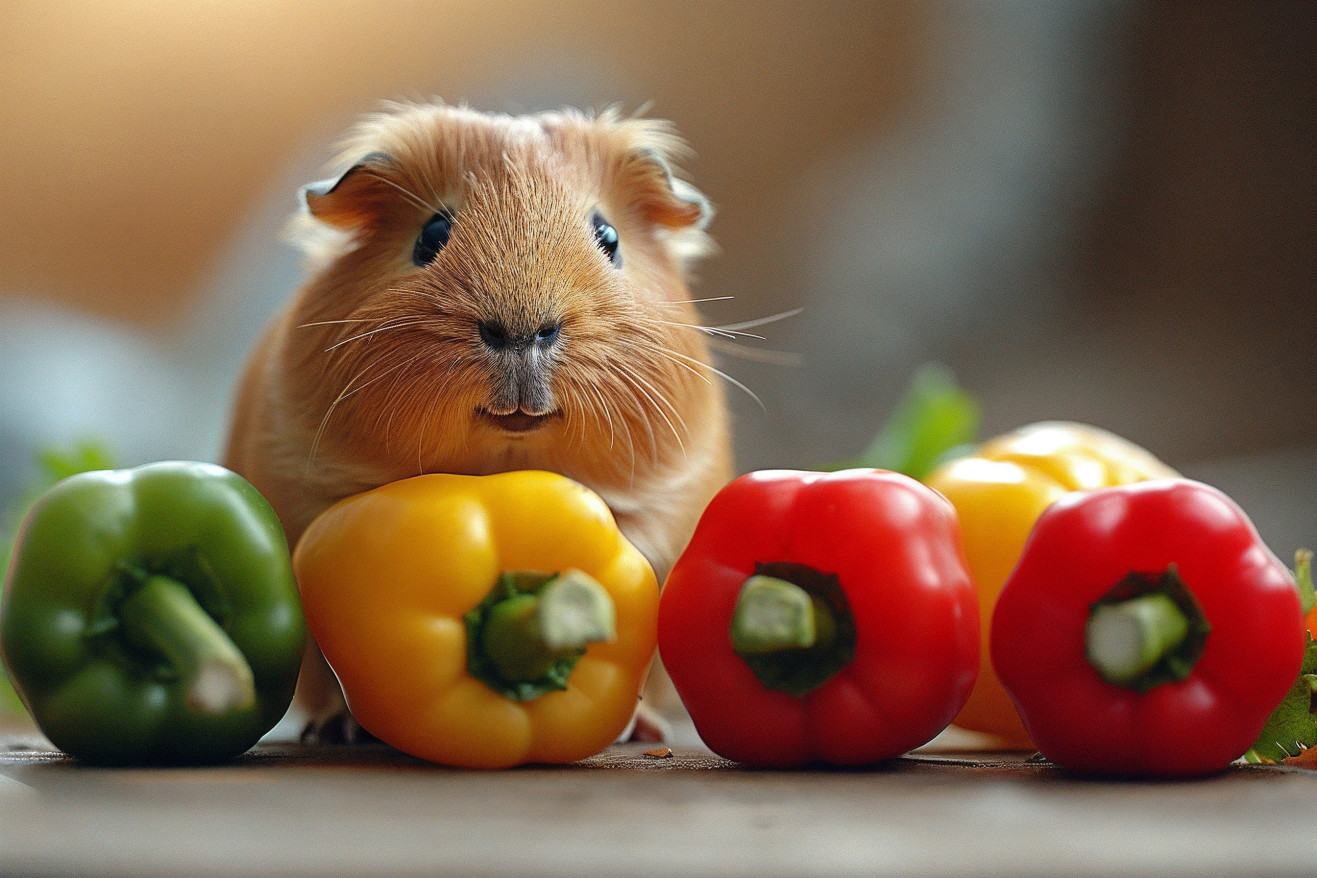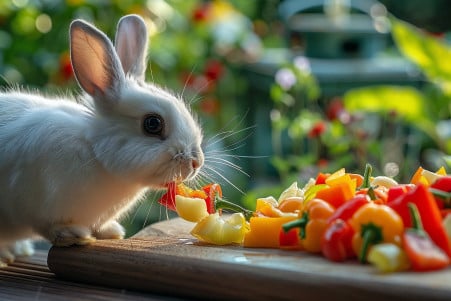Can Guinea Pigs Eat Bell Peppers? Nutritional Guidelines Explored
9 February 2024 • Updated 9 February 2024

Guinea pigs have very particular dietary requirements, but how do bell peppers fit into their nutritional needs? The good news is that guinea pigs can eat bell peppers. Bell peppers are high in Vitamin C, which is essential for guinea pigs.
However, it’s important to make sure you remove the seeds and stem and feed them in moderation to avoid upsetting your guinea pig’s stomach. Make sure to introduce bell peppers slowly to your guinea pig.
This article will go over the details of guinea pig nutrition and how fruits and vegetables fit into their diet. It will also look at veterinary recommendations and scientific research to help you better understand the pros and cons of feeding bell peppers to guinea pigs.
With a better understanding of what guinea pigs need from their diet, we hope to give you a complete overview of how to safely feed your pet bell peppers.
Can guinea pigs eat bell peppers?
What Should You Feed Your Guinea Pig?
Guinea pigs require a specific diet to ensure they live long, healthy lives. According to the RSPCA, this diet should be based on a constant supply of good-quality hay and fresh grass, which are essential for digestion and maintaining healthy teeth.
This means that hay and grass should make up the majority of a guinea pig’s diet. The RSPCA also recommends that this diet be supplemented with a daily serving of grass-based pellets that are fortified with Vitamin C, which guinea pigs can’t produce on their own.
As The Humane Society of the United States points out, Vitamin C is essential for guinea pigs’ health and can help prevent issues like scurvy.
In addition to these staples, guinea pigs should also be fed fresh vegetables and a limited amount of fruit. This will help ensure that they get the nutrients they need and keep their diet interesting.
The RSPCA recommends that guinea pigs be fed leafy greens and vegetables that are high in Vitamin C, like bell peppers and broccoli, every day to ensure that they get enough of this essential nutrient. That said, some fruits and vegetables are high in sugar or oxalates and should be fed to guinea pigs in moderation.
Guinea pig owners should also be prepared to adjust the amount of food they feed their pets to help them maintain a healthy weight. This means that they should consider their guinea pig’s age, activity level, and overall health when determining how much to feed them.
They should also pay attention to how their pets respond to new foods when they’re introduced. A well-rounded diet is essential to guinea pigs’ overall health and well-being.
Since bell peppers are high in Vitamin C, they can be a good addition to a guinea pig’s diet if they’re fed to the animals in the right way.
Bell Peppers: Packed With Nutrients That Guinea Pigs Need
Bell peppers are packed with nutrients that are well-suited to a guinea pig’s dietary needs. One of the most important nutrients that guinea pigs need is Vitamin C, and since guinea pigs can’t produce their own Vitamin C, they need to get it from their diet. According to Verywell Health, a medium-sized red bell pepper contains 152mg of Vitamin C, which is more than enough to meet a guinea pig’s daily needs.
In addition to their high Vitamin C content, bell peppers are also rich in other antioxidants, including beta carotene, which the body converts into Vitamin A, and a number of carotenoids, including capsanthin and violaxanthin, according to Healthline. Antioxidants are important for overall health and can help protect cells from damage caused by free radicals.
When it comes to sugar and fiber, bell peppers are low in sugar and high in fiber compared to other foods that guinea pigs eat. This makes them a great option for helping to make sure that a guinea pig’s diet is well-rounded without the risk of too much sugar, which can be a concern with some fruits.
As a result, regularly feeding guinea pigs bell peppers can help them meet their vitamin needs while also providing them with important antioxidants and other nutrients that can help support their overall health, making them an important part of a well-rounded and nutritious diet.
How to Add Bell Peppers to Your Guinea Pig’s Diet
Like all new foods, you should add bell peppers to your guinea pig’s diet slowly to avoid any stomach upset. Start by giving your guinea pig a small piece of bell pepper and monitor them for any signs of intolerance, including diarrhea or a change in appetite. Then, as GuineaDad recommends, work up to a full serving over the course of several days, watching your guinea pig’s reaction to the new food.
The Southern California Guinea Pig Rescue recommends that a full serving of vegetables, including bell peppers, should not exceed one to one and a half cups per day. Bell peppers can be part of this mix of vegetables a few times a week, which will help make sure your guinea pig’s diet is well-rounded and doesn’t lead to any nutritional imbalances.
Make sure to wash the bell peppers thoroughly to remove any pesticides or other contaminants, and always remove the seeds and stem before feeding them to your guinea pig.
By doing this, you can ensure that you’re giving your guinea pig safe, clean bell peppers that will help them get the vitamins and minerals they need. Remember, it’s important to be patient and to monitor your guinea pig closely whenever you introduce a new food to their diet.
Managing the Dangers of Vegetables in Guinea Pig Diets
Vegetables are an important part of a guinea pig’s diet, providing important nutrients and keeping their diet interesting. However, it’s important to understand the dangers so that you can keep your pet safe.
According to Guinea Piggles, some of the dangers of overfeeding vegetables to guinea pigs include digestive problems like bloat and nutritional imbalances.
A healthy diet will include a mix of leafy greens, vegetables, and fruits, but there are some things that should be avoided completely. For example, The Anti-Cruelty Society warns against feeding guinea pigs iceberg lettuce due to its lack of nutritional value and its potential to cause diarrhea.
The RSPCA stresses the importance of a varied diet and moderation. When you’re introducing new vegetables, do it slowly and in small amounts, and keep an eye on your pet for any negative reactions.
Foods like potatoes, cabbage, and broccoli can lead to bloating and should be fed in moderation. It’s also important to know which foods to avoid altogether, including avocados, onions, and anything with caffeine or chocolate, as these are all toxic to guinea pigs and should never be part of their diet.
As you adjust your guinea pig’s diet, watch for signs that they’re healthy and make changes as needed. A varied diet will help ensure that they’re getting the nutrients they need while also preventing boredom that could lead to a lack of interest in eating and other health problems.
Conclusion: Can Guinea Pigs Eat Bell Peppers?
In conclusion, guinea pigs can eat bell peppers and will benefit from the high levels of Vitamin C that they contain. Vitamin C is important for preventing deficiencies like scurvy, and bell peppers also contain a range of other important nutrients and antioxidants that can help support your guinea pig’s overall health.
Always remember to follow the golden rule of introducing new foods slowly: start with a small piece and watch for any negative reactions. This, in combination with close observation and the ability to adjust portion sizes, will help you avoid any digestive issues.
Feed your guinea pig bell peppers as a treat, but not as a main part of their diet; they should be used as a supplement to a diet that is primarily made up of hay, fresh grass, and high-quality pellets.
It’s important to make sure that you, as a pet owner, are aware of your guinea pig’s specific dietary requirements and that you are providing a well-rounded diet that includes a variety of different nutrients.
It’s also important to remember to feed these items in moderation and to watch for any signs of trouble to make sure that your pet stays safe. If you follow these rules, you’ll be able to help your pet live a happy, healthy life.


